Since I moved to Minnesota, a lot of people have told me about the Boundary Waters Canoe Area Wilderness, a remote area in the northern most part of the state that extends nearly 150 miles along the Canadian border. With countless glacial lakes and streams, the forested area spans more than one million acres. It is the largest remaining area of uncut forest in the eastern US. Today, there are strict limitations on boats and snowmobiles, and permits regulate how many people are allowed in at one time.
 When you buy something using links in our stories, we may earn a small commission. Read more about our policy.
When you buy something using links in our stories, we may earn a small commission. Read more about our policy.
Portaging the Boundary Waters
You can neither backpack the Boundary Waters nor boat through, but you can combine the two into what’s known as portaging. Here’s how it works: grab your tent, sleeping bag, clothes, food, etc.—putting the most precious gear in waterproof packs—and hop into a canoe. When you hit dry land, pick up your pack(s) and your canoe(!), and walk to the next body of water and get back in the vessel. Depending on how many people are in your group and how much stuff you packed, you may need to make two trips on the trails.
Portaging was an entirely new concept to me and I wasn’t really sure what to make of it, but I was definitely interested in trying it, especially if it got me into one of Minnesota’s most popular areas for outdoor adventure. So when some friends invited us over Labor Day weekend to join their trip, the answer was an immediate and resounding YES.
Aaron, our fearless leader, graciously agreed to take five newbies into the backcountry and planned the entire trip for us. It would be his 12th Boundary Waters adventure and his first summer making the trip twice. We were in good hands. And you need to be in good hands because the Boundary Waters is very remote with a very limited number of permits, and therefore, people. You need to know what you’re doing and more importantly, where you’re going.
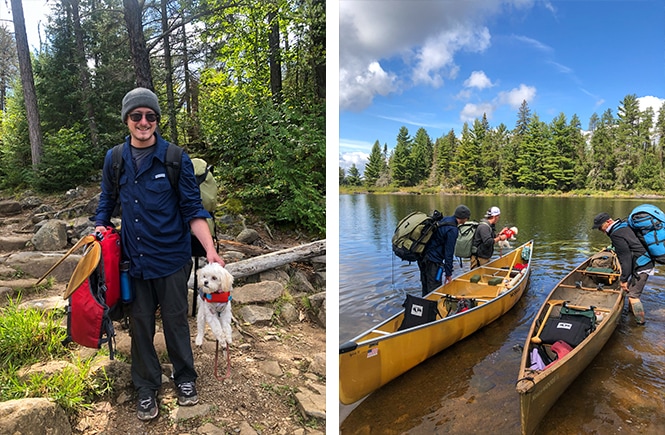
Planning for a Boundary Waters trip
Our crew met a few weeks before departure date for a planning session, during which Aaron answered lots of our questions.
Q: How far will we paddle over the three days?
A: 30 miles roundtrip, so roughly 15 miles each way. We’ll go the entire length on the first day, camp, paddle back about half-way the second day, camp, and then finish the route the following morning before hitting up a brewery in Duluth on the way home.
Q: How often and how far do you carry the canoe?
A: I’ve planned a route for us with a moderate number of portages and made sure none of them are too long. From looking at the map, we will have about a dozen portages each direction. The distances on land are measured in rods, which equates to the length of a canoe. Our shortest portage is 10 rods, and the longest is 95 (.3 miles).
Q: And how much does a canoe weigh, exactly?
A: Our rented canoe will be about 40 lbs. It’s pretty manageable once you get it overhead. The trick is definitely getting it up.
Q: So, do we pack as light as if we’re backpacking?
A: Yes and no. Since we do have to carry all of our stuff while on land, we definitely want to be cognizant of weight and how much we bring, but we can splurge on things like a pot and pan, wine, a hammock, camera gear and tripod, etc. We’ll be eating well, that’s for sure. I’ll give you a detailed list of what to pack—and what not to pack.
Q: Are you sure a paper map and compass are the only navigation tools we need?
A: Yes, I’m hardcore and old school. I got this.
Q: But what if you don’t got this? Getting lost in the wilderness is no joke. Or what if one us gets hurt?
A: We’ll have a radio tracking us and can call for help if there’s any emergency. The outfitter that provides transportation, canoes, and a place for us to sleep the night before and shower the last day will give it to us just in case.
(I’m paraphrasing, but this was more or less the gist of things.)
This would be my first outdoor adventure where a tracking device is needed or offered. How exciting! It would also be fun to plot our progress so afterward we can see exactly where we went and how far.
Canoe camping gear guide
Check out our complete camping packing list for all the essentials like camp items (tent, sleeping bag, sleeping pad, etc.), kitchen items (pots/pans, bowls/cups, utensils, etc.), and personal items (sunscreen, hat, first aid kit, etc.). While this is a general camping list, a lot of the same applies. But a canoe camping trip requires a few extra pieces of gear.
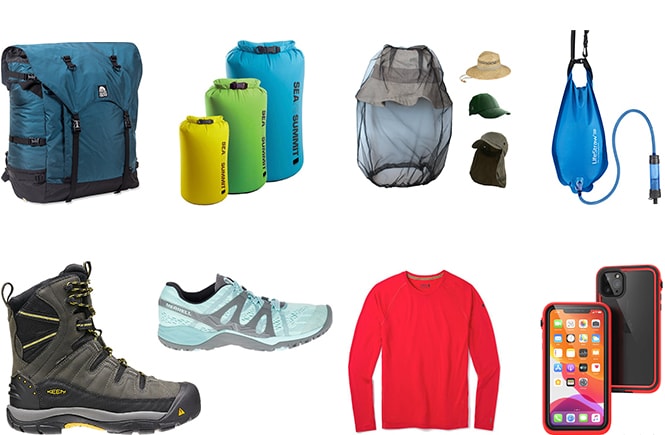
Product details below are listed in order of left to right starting with the top row.
Granite Gear Superior One Portage Canoe Pack
Minnesota-based Granite Gear makes some of the best canoe accessories, including these large portage packs. While this model isn’t a dry bag (i.e. waterproof), they do make those, too. The reason for a portage pack specifically is the shape. They’re designed to easily come in and out of a canoe without getting caught up on anything. They’re also a shorter, more stout pack than a traditional backpack, allowing space on your upper back and shoulders for the canoe to rest.
Sea to Summit Lightweight Dry Sacks
If you don’t get a waterproof portage pack, you can easily put the most important gear (clothes, electronics, etc.) in a dry sack. In the worst case scenario—that you tip the canoe or drop your bag into the lake—these stuff sacks are air tight and keep everything completely dry.
Benvo Mesh Head Net
While we didn’t have to use these fancy masks, it is definitely a necessary piece of gear for venturing into the wilderness. Mosquitoes are the unofficial state bird of Minnesota, and you do not want to underestimate the power of these pests to absolutely ruin your experience if you’re unprepared. In addition to bug spray (which is one of many essentials on the camping packing list you should bring), these flattering bug nets give an added layer of protection and peace of mind, keeping those mosquitos and gnats at a safe distance.
LifeStraw Flex with Gravity Bag Water Filter
There’s no water source out in the Boundary Waters, though water is plentiful in all the lakes and streams. You definitely need to bring along some sort of water filter. We love this system that uses gravity. It’s super easy to use and packs down small. Simply fill the bag with water and find a place to hang it in a nearby tree. Open the spout and let gravity do its job. A clean filter (meaning water moves through faster) can fill a Nalgene in a couple minutes.
KEEN Summit County Winter Boots
You have two options for footwear. This is #1. Your feet will get wet. You will step in shallow water getting in and out of the canoe almost every portage. If you don’t want to get wet, wear a high waterproof boot. Unless you take a serious tumble, this should keep your toes completely dry.
Merrell Siren Hex Q2 E-Mesh Hiking Shoes
Option #2—and my preference—is to embrace your surroundings and let your feet get wet. A light mesh shoe with a bit of traction on the bottom is the minimalist’s choice of footwear. I love feeling the water on my feet, and you can still easily hike/walk safely in a shoe like this.
Smartwool Merino 150 Crew Base Layer
You can wear a tank top, t-shirt, and/or long sleeved top, but the important part here is that its moisture wicking. You will be wet with potentially lake water but more likely sweat at some point, so invest in a quality base layer. From there, depending on the forecast, add more layers and a lightweight jacket. And, don’t forget rain gear.
Waterproof Case
Of course you’ll want your phone handy throughout the trip. Not because you get any service in the wilderness, but for the occasional photo op. While some phones are water resistant/proof, I always like to protect mine a little extra with a case. Not only are these cases waterproof, but they’re more durable than most other phone cases and better protect against drops and dings.

MORE: Read our travel companions’ trip report over at Minnevangelist, their website dedicated to “spreading the gospel of Minnesota’s greatness”
A sample Boundary Waters itinerary
Day one
The night before, we drove up to Ely, MN and stayed in the outfitter’s bunkhouse. Aaron booked us through Voyager North. An outfitter isn’t necessary, but it does streamline the process. They will handle the permits, canoes, bunkhouse, post-trip showers, help with route planning, etc.

We woke up early the next morning and hopped in a big van with the canoes side-by-side on the roof, back full of our gear, paddles, and life jackets. We drove about 30 minutes to our entry point on Lake 1. The morning fog rose off the small bay, and the day was full of promise.
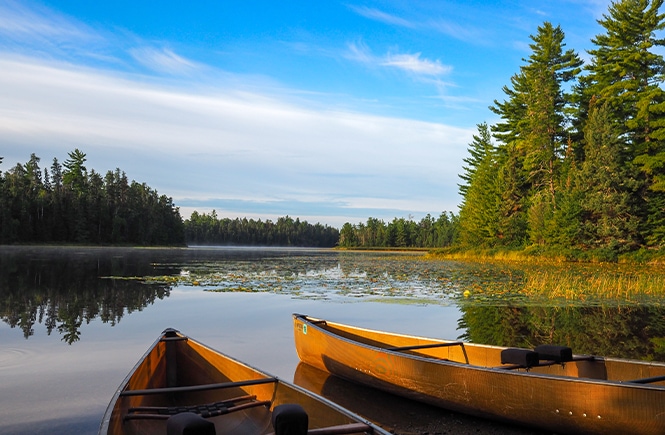
We all managed to get into the canoes without tipping—off to a great start!—and pushed away from the shore. Settling into our spots, Aaron gave us some quick advice on paddling and steering and lingo for navigating, and we set off. Immediately, we took a few wrong turns, and my navigational nightmares returned. At least it was only 8am and we had 12 hours of daylight to sort it out, which Aaron quickly did, and we continued on our way. Phew, that was close.
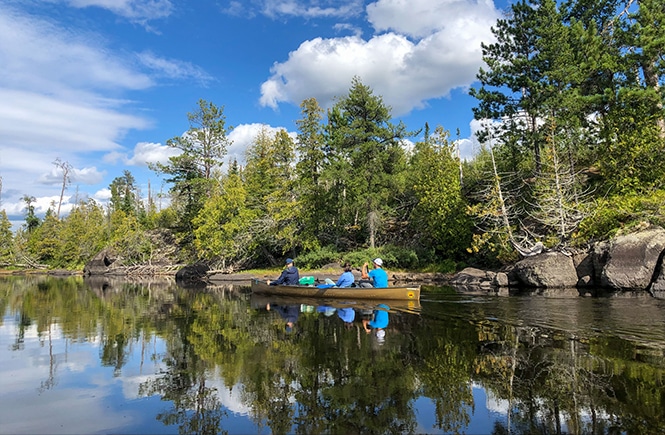
We had two canoes with three people each. Aaron and Travis were the stern paddlers, sitting in back responsible for steering the vessels. The rest of us took turns trying out the middle and front seats. After a few portages, we all figured out our preference and settled into a nice rhythm by lunch time. Lunch consisted of bagels and Bald Eagle spotting. We filtered lake water into drinking water with Loons playing the background. It was a picture perfect late summer day.
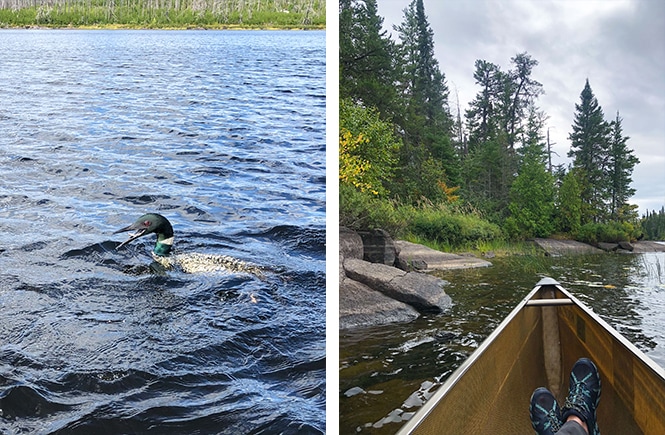
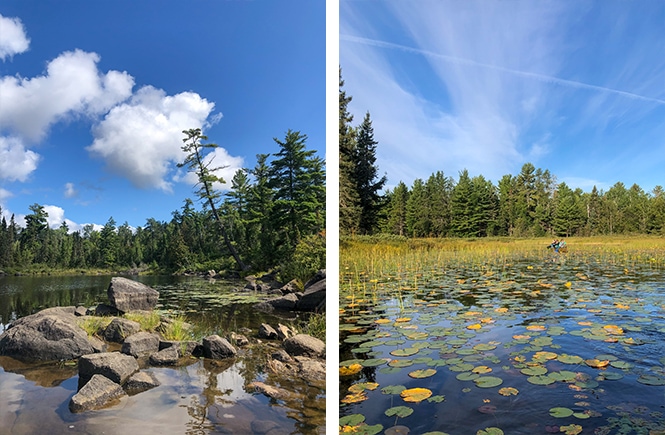
Back in the canoes, we had another four or so hours ahead of us. Spirits were up. We were doing it!
Fast forward to 3pm, and everyone was pretty much over it. Hands were blistering, shoulder muscles were getting sore. One row and then the next… just.keep.rowing.
It wasn’t necessarily hard work. It was just tedious work. And you move so dang slow. I kept thinking about how terribly inefficient canoeing seemed. I was trying to calculate if we were going faster or slower than if we’d been walking. Ya know, if there was dry land instead of this water to pass through.
Then I remembered we had wine, pancakes, and numerous other creature comforts you wouldn’t have with traditional backpacking, and that was cool and worth it and just.keep.rowing. Turns out, if you want to be here, in this pristine wilderness with more eagles than humans, this is how you do it. And how cool is that?
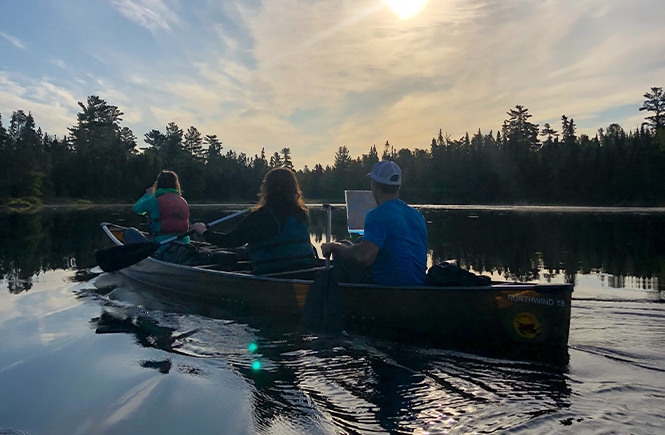
Around 4pm, we got slightly lost again trying to find the campground. We were tired and hangry and ready to hunker down for the night. Tempers successfully stayed in check, and Aaron—yet again—sorted it out and got us back on track.
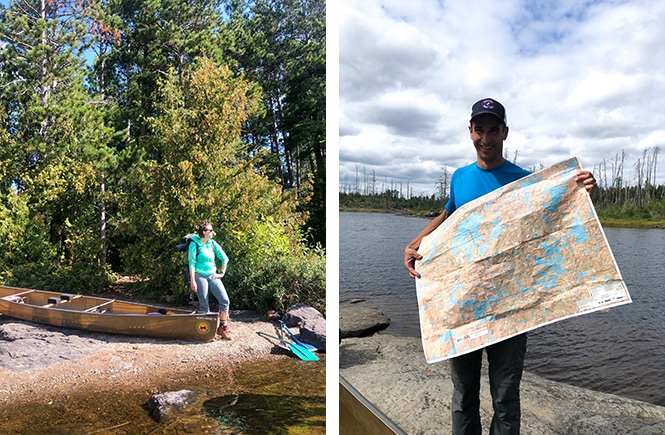
We arrived to the campsite. The views were incredible, and we were well positioned for that night’s starry spectacular. It was high time for spotting the galactic center, and if we’re lucky, we’ll see some northern lights. YES, PLEASE.
We made dinner. Two actually. (Like I said, not skimping on creature comforts like multi-course meals.) Dinner consisted of a traditional campers’ meal (tin foil packets full of spicy sausage, onions, carrots, and potatoes—real hearty stuff) and salmon, which Aaron slapped right onto the grill. Delicious. The wine even more delicious. After s’mores, the sun set and, sure enough, the northern lights rose.
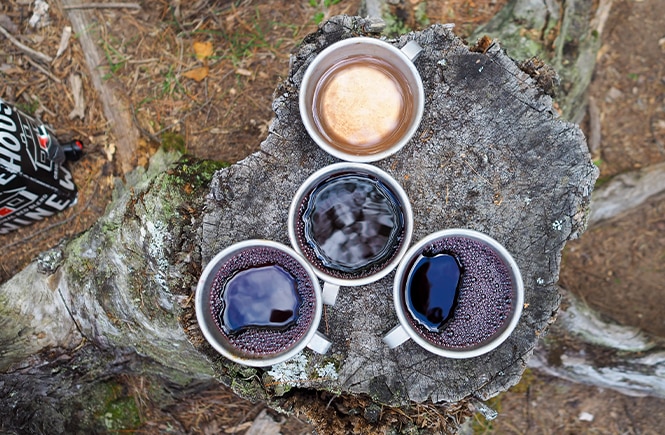
In real life, we saw a very faint white shine coming up over the horizon. It was barely noticeable, if I’m being honest. Aaron put his camera on a tripod and snapped a pic. Bright blues, purples, pinks, greens. WHAT. It was amazing. And more than the eye could see, for sure.
We turned our gaze and attention to the south, and the galactic center was on full display. You could see the Milky Way spanning across a huge portion of the sky. More stars than I’ve ever seen, and I’ve camped in official dark sky parks. I was too tired to get my camera and didn’t even bother bringing a tripod since my photography skills aren’t quite at that level, but Aaron got some awesome photos. A magical ending to day one.

Day two
Bacon, eggs, and coffee to start the day. We leisurely packed up camp and set off, assuming our same positions from yesterday. We were back in the boat by 10am and had just half the distance to travel today. There wasn’t a worry in the world. Besides, we were pros at the whole thing by now.
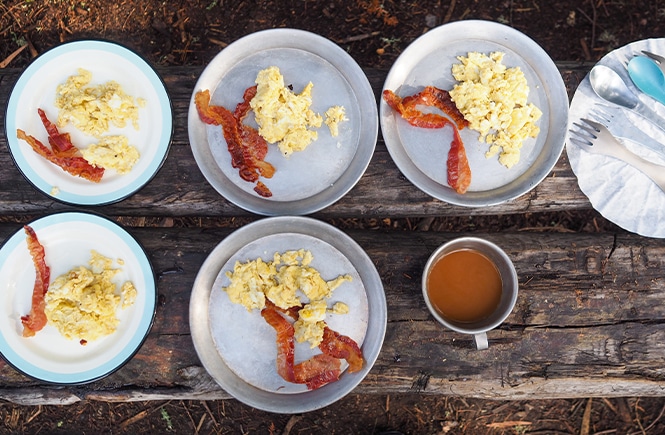
The forecast today called for clouds and cooler temps. There was a slight breeze and threats of rain. By early afternoon, we were battling whitecaps in our flimsy little canoes. Just kidding. There were actually minuscule whitecaps on the tiny ripples if you looked close enough, but the canoes were more than sturdy. We were, however, paddling into the wind, which meant moving even slower than normal. It was actually kind of exciting having a bit of weather to contend with and pretending to be on some extreme wilderness show on the Discovery Channel.

Of course we persevered and rolled into our camp spot—nestled on the tip of a sweet little peninsula—by early afternoon. The forest was much less dense here, and we roamed around on little trails exploring the area. After locating the latrine—first order of business—and devising a plan to tell others from afar if it was in use, we went back to home base and started to set up camp.
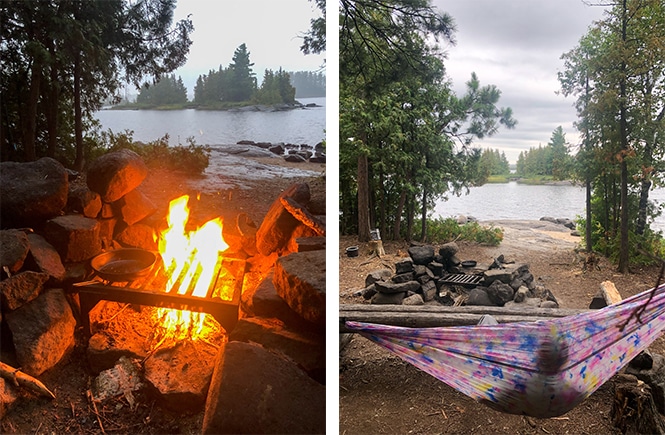
Tonight’s dinner was another camp specialty: hot dogs and instant mashed potatoes. As we were eating, the rain eventually did roll in. We retreated to our tents to wait it out. Naturally, we all fell asleep. I heard Aaron and his wife, Morgan, out of their tents after the rain stopped but couldn’t muster the energy to join them for s’mores and another fire. I knew they’d be packing up the food and hanging the bag from a tree to keep the bears away. I felt guilty for not helping and fell back to sleep two seconds later. Woops. Thanks, guys!
Side note on bears: we didn’t see any, but you never know. Bear safety is a big deal in any wilderness area. It’s important to keep food out of reach or in a bear-proof canister, and you shouldn’t bring any toiletries with strong odors like deodorant. Any lotions, toothpaste, etc., should also be hung.
Day three

The outfitter was scheduled to pick us up at 1pm from the drop-off location. We only had about two hours of canoeing ahead of us, so we had a lovely, leisurely breakfast, which consisted of more bacon and eggs and this time, pancakes, too. Oh, what a sweet, sweet indulgence to nosh on flapjacks in the middle of a very serene wilderness with a few friends and pretty much no one else around for miles and miles.

We set off on our last leg, sad this time had come so fast. Rightfully so, Travis got tired of portaging, and I really wanted to try to carry the canoe, so this would be my day. With his help getting it up, I ducked underneath, rested my shoulders below the pads, and stood up. It wasn’t that heavy (I work out), and I figured out how to balance it pretty quickly. I was off. It was a short distance—I think 15 rods—and when I got to the end of the trail, he helped me plop the boat gently back into the water. I loved it and wished I’d started portaging sooner! I gladly and giddily did the rest of the portages that day.

We got back to the outfitter’s and took full advantage of the showers before hitting the road. It felt gooooood to be clean, and it was going to feel better to have a beer. We drove to Duluth and settled in at Fitgers for burgers and beer and immediate reminiscing about the past three days.
We all unanimously agreed it was a huge success. No one flipped a canoe or broke an ankle. All the newbs survived—no, thrived!
Endless gratitude for Aaron planning the whole thing. For navigating with a paper map and compass. For, most of all, the pancakes.

Our Boundary Waters route
As it turns out, we forgot to check in throughout our journey using the radio that would’ve plotted our route more precisely. We did check in a few times (first photo) and then were able to figure out the route based on where we camped the first night on Google Earth (second photo). All in, we paddled/portaged about 15 miles. Not bad for a bunch of noobs.

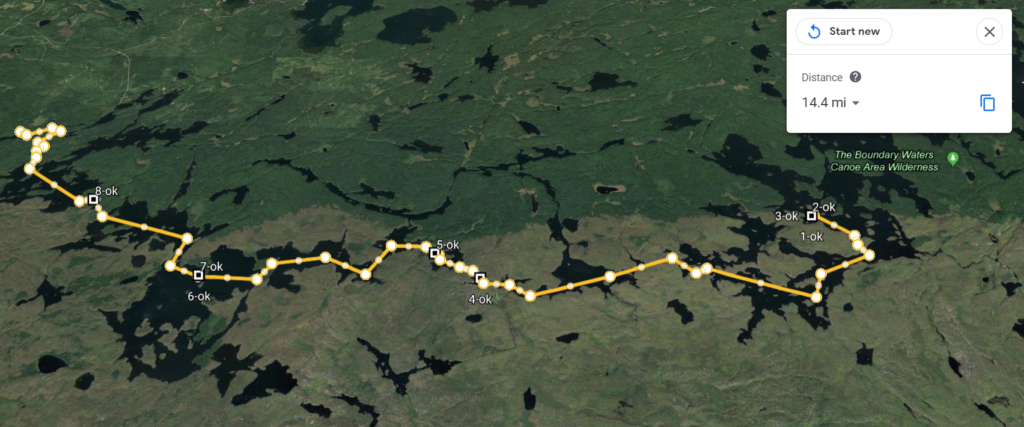

 When you buy something using links in our stories, we may earn a small commission.
When you buy something using links in our stories, we may earn a small commission.